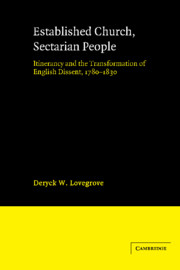 Established Church, Sectarian People
Established Church, Sectarian People Book contents
- Frontmatter
- Contents
- List of figures
- Preface
- Acknowledgements
- List of abbreviations
- 1 The Established Church and English Separatism
- 2 Itinerancy and Dissent
- 3 Preachers and sponsors
- 4 The academic leaven
- 5 Organization and infrastructure
- 6 Support and opposition
- 7 Criticism and legality
- 8 Developments and trends
- Conclusion
- Appendix A Journal of T[homas] Wastfield, June 1797–April 1798
- Appendix B Organizations active in itinerant evangelism
- Appendix C Baptismal statistics
- Notes
- Bibliography
- Index
2 - Itinerancy and Dissent
Published online by Cambridge University Press: 13 October 2009
- Frontmatter
- Contents
- List of figures
- Preface
- Acknowledgements
- List of abbreviations
- 1 The Established Church and English Separatism
- 2 Itinerancy and Dissent
- 3 Preachers and sponsors
- 4 The academic leaven
- 5 Organization and infrastructure
- 6 Support and opposition
- 7 Criticism and legality
- 8 Developments and trends
- Conclusion
- Appendix A Journal of T[homas] Wastfield, June 1797–April 1798
- Appendix B Organizations active in itinerant evangelism
- Appendix C Baptismal statistics
- Notes
- Bibliography
- Index
Summary
The period after 1780 was as important for ecclesiastical life as it was for the evolution of English society as a whole. For Protestant Dissent the historical significance of the ensuing decades was if anything even greater than for those groups which sought to defend the privileges of the Established Church. For the former the late eighteenth century represented the crucial stage in its development; the process of change from contemptible insignificance to the full flower of Victorian Nonconformity. The point of transition was marked by a new and highly visible phenomenon; the widespread employment of itinerant evangelism. Itinerancy had operated in desultory fashion since the mid-seventeenth century, but for the majority of congregations the age of the field preacher did not commence until the period of conflict with Revolutionary France. As the practice began to spread during the 1790s the gains resulting from its application were immediate and obvious. Long before the defeat of Napoleon in 1815 it had enabled Dissent to penetrate deeply into the fabric of rural society, especially in areas where Methodism was weak. In the light of this achievement and the degree of anxiety aroused in contemporary minds by the undeniable success of popular preaching, it is all the more surprising that its social prominence during a period of unprecedented tension has been almost entirely overlooked.
One important break in this silence was made in the early twentieth century by the French historian, Elie Halévy.
- Type
- Chapter
- Information
- Established Church, Sectarian PeopleItinerancy and the Transformation of English Dissent, 1780–1830, pp. 14 - 40Publisher: Cambridge University PressPrint publication year: 1988
- 1
- Cited by
